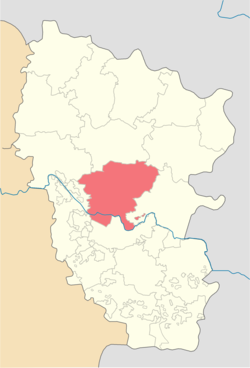Novoaidarskyi Raion
Новоайдарський район | |
|---|---|
 | |
| Coordinates: 48°57′34″N 38°58′32″E / 48.95944°N 38.97556°E | |
| Country | |
| Region | Luhansk Oblast |
| Established | 1923 |
| Disestablished | 18 July 2020 |
| Admin. center | Novoaidar |
| Subdivisions | List
|
| Government | |
| • Governor | Mykola Zahodyachenko |
| Area | |
| • Total | 1,536 km2 (593 sq mi) |
| Population (2020) | |
| • Total | |
| Time zone | UTC+02:00 (EET) |
| • Summer (DST) | UTC+03:00 (EEST) |
| Postal index | 93500—93543 |
| Area code | +380 6445 |
| Website | http://ndar.loga.gov.ua |
Novoaidar Raion (Ukrainian: Новоайдарський район) was a raion (district) in Luhansk Oblast in eastern Ukraine. The administrative center of the raion was the urban-type settlement of Novoaidar. The raion was abolished on 18 July 2020 as part of the administrative reform of Ukraine, which reduced the number of raions of Luhansk Oblast to eight, of which only four were controlled by the government.[1][2] The last estimate of the raion population was 39,700 (2020 est.).[3]
History
[edit]Starting mid-April 2014 pro-Russian separatists captured several towns and raions in Luhansk Oblast;[4][5] Ukrainian forces reportedly removed the separatists from the last village of Novoaidar Raion under separatist control, Krymsky, on 20 October 2014.[6]
To facilitate the governance of Luhansk Oblast during the War in Donbass, the Verkhovna Rada on 7 October 2014 made some changes in the administrative divisions, so that the localities in the government-controlled areas were grouped into districts. In particular, the town of Shchastia was transferred from Luhansk Municipality to Novoaidar Raion. Some areas were transferred to the raion from Slovianoserbsk Raion.
Demographics
[edit]As of the 2001 Ukrainian census:[7]
- Ethnicity
- Ukrainians: 56.1%
- Russians: 42.7%
- Belarusians: 0.4%
References
[edit]- ^ "Про утворення та ліквідацію районів. Постанова Верховної Ради України № 807-ІХ". Голос України (in Ukrainian). 2020-07-18. Retrieved 2020-10-03.
- ^ "Нові райони: карти + склад" (in Ukrainian). Міністерство розвитку громад та територій України.
- ^ Чисельність наявного населення України на 1 січня 2020 року / Population of Ukraine Number of Existing as of January 1, 2020 (PDF) (in Ukrainian and English). Kyiv: State Statistics Service of Ukraine. Archived (PDF) from the original on 28 September 2023.
- ^ Ragozin, Leonid (16 April 2014). "Vladimir Putin is Accidentally Bringing Eastern and Western Ukraine Together". The New Republic.
- ^ http://en.itar-tass.com/world/735082
- ^ "Українські військові звільнили Кримське від терористів". IPress. 19 October 2014.
Krymske in Luhansk region liberated ‘without a shot fired’, UNIAN (20 Oct. 2014) - ^ "Home". ukrcensus.gov.ua.


Well, that’s interesting to know that Psilotum nudum are known as whisk ferns. Psilotum nudum is the commoner species of the two. While the P. flaccidum is a rare species and is found in the tropical islands. Both the species are usually epiphytic in habit and grow upon tree ferns. These species may also be terrestrial and grow in humus or in the crevices of the rocks.
View the detailed Guide of Psilotum nudum: Detailed Study Of Psilotum Nudum (Whisk Fern), Classification, Anatomy, Reproduction